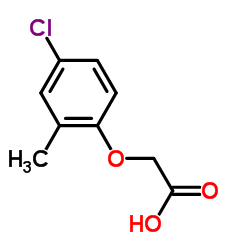MCPA

MCPA structure
|
Common Name | MCPA | ||
|---|---|---|---|---|
| CAS Number | 94-74-6 | Molecular Weight | 200.619 | |
| Density | 1.3±0.1 g/cm3 | Boiling Point | 327.0±27.0 °C at 760 mmHg | |
| Molecular Formula | C9H9ClO3 | Melting Point | 114-118 °C(lit.) | |
| MSDS | Chinese USA | Flash Point | 151.6±23.7 °C | |
| Symbol |


GHS02, GHS07 |
Signal Word | Danger | |
|
Quantitative structure-activity relationship and complex network approach to monoamine oxidase A and B inhibitors.
J. Med. Chem. 51 , 6740-51, (2008) The work provides a new model for the prediction of the MAO-A and -B inhibitor activity by the use of combined complex networks and QSAR methodologies. On the basis of the obtained model, we prepared and assayed 33 coumarin derivatives, and the theoretical pr... |
|
|
Monetite granules versus particulate autologous bone in bone regeneration.
Ann. Anat. 200 , 126-33, (2015) The aim of this study was to test bone tissue response to monetite granules in comparison with intramembranous autologous bone graft in a rabbit calvaria critical size defect model.Novel monetite granules were synthesized by thermal conversion of set brushite... |
|
|
The role of microbial adaptation and biodegradable dissolved organic carbon on the attenuation of trace organic chemicals during groundwater recharge.
Sci. Total Environ. 437 , 137-44, (2012) It is widely recognized that efficient biological attenuation of bulk organic matter and trace organic chemicals (TOrC) can occur in managed aquifer recharge (MAR) systems receiving reclaimed water. The heterotrophic microbial activity in these subsurface sys... |
|
|
Enhancement of micropollutant degradation at the outlet of small wastewater treatment plants.
PLoS ONE 8(3) , e58864, (2013) The aim of this work was to evaluate low-cost and easy-to-operate engineering solutions that can be added as a polishing step to small wastewater treatment plants to reduce the micropollutant load to water bodies. The proposed design combines a sand filter/co... |
|
|
Risk assessment of pesticides detected in surface water of the Alqueva reservoir (Guadiana basin, southern of Portugal).
Sci. Total Environ. 488-489 , 208-19, (2014) The purpose of this study was to evaluate the potential impact of the pesticides detected in the Alqueva reservoir (Guadiana Basin, South Iberian Peninsula) on the aquatic organisms belonging to this ecosystem. For this purpose, the occurrence and risk assess... |
|
|
Resorption of monetite calcium phosphate cement by mouse bone marrow derived osteoclasts.
Mater. Sci. Eng. C. Mater. Biol. Appl. 52 , 212-8, (2015) Recently the interest for monetite based biomaterials as bone grafts has increased; since in vivo studies have demonstrated that they are degradable, osteoconductive and improve bone healing. So far osteoclastic resorption of monetite has received little atte... |
|
|
Surfactant toxicity in a case of (4-chloro-2-methylphenoxy) acetic acid herbicide intoxication.
Hum. Exp. Toxicol. 34 , 848-55, (2015) Self-poisoning with (4-chloro-2-methylphenoxy) acetic acid (MCPA) is a common reason for presentation to hospitals, especially in some Asian countries. We encountered a case of a 76-year-old woman who experienced unconsciousness, shock and respiratory failure... |
|
|
Combined isotope and enantiomer analysis to assess the fate of phenoxy acids in a heterogeneous geologic setting at an old landfill.
Water Res. 47(2) , 637-49, (2013) Phenoxy acid herbicides and their potential metabolites represent industrial or agricultural waste that impacts groundwater and surface waters through leaching from old landfills throughout the world. Fate assessment of dichlorprop and its putative metabolite... |
|
|
Treatment of 2,4-D, mecoprop, and dicamba using membrane bioreactor technology.
Environ. Sci. Pollut. Res. Int. 20(8) , 5188-97, (2013) Phenoxyacetic and benzoic acid herbicides are widely used agricultural, commercial, and domestic pesticides. As a result of high water solubility, mobility, and persistence, 2,4-dichlorophenoxyacetic acid (2,4-D), methylchlorophenoxypropionic acid (mecoprop),... |
|
|
Stereoselective quantitation of mecoprop and dichlorprop in natural waters by supramolecular solvent-based microextraction, chiral liquid chromatography and tandem mass spectrometry.
Anal. Chim. Acta 761 , 102-8, (2013) Liquid chromatography (LC)/tandem mass spectrometry (MS/MS) after supramolecular solvent-based microextraction (SUSME) was firstly used in this work for the enantioselective determination of chiral pesticides in natural waters. The method developed for the qu... |